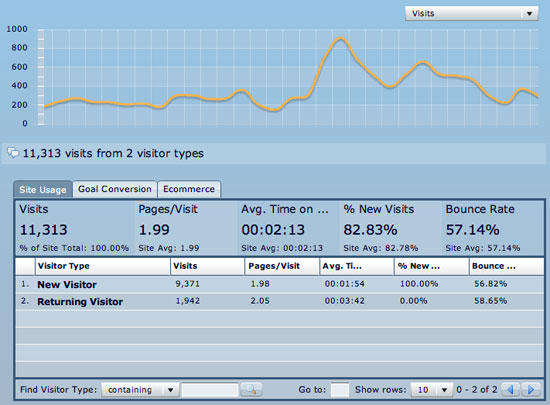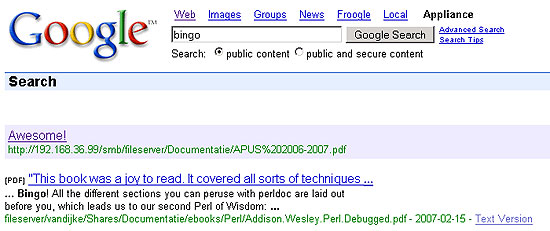The Google Mini - A look at Google's entry-level search appliance
by Liz van Dijk on December 21, 2007 12:00 AM EST- Posted in
- IT Computing
Exploring the Mini's possibilities...
Part of the Google Mini's appeal lies in its ability to customize the user's search experience to a great extent, thanks to considerable added functionality. We will be looking at some of these options now.
OneBox
One of these interesting additions to the Mini is the OneBox functionality. You might know OneBox already from your standard Google searches, where Google uses its different applications to provide you with specific results. In the example below, searching for the location of our lab on a map provides us with a special result that integrates the Google Maps application.
 Doing a search on our lab's address gives us a nice map of the location. |
Of course, this feature wasn't plainly copied over into the Mini, since people could simply use the standard Google to make use of these possibilities. Instead, Google released an SDK for companies to write their own OneBox modules, and makes existing modules available for download from their gallery. These modules can plug into various existing systems in the Mini owner's network, ranging from LDAP databases to Exchange servers, extracting company-specific data such as employees' contact information, charts and sales numbers. This is interesting for a mostly intranet-based use of the Mini, but the possibilities of OneBox reach beyond that. With the proper OneBox modules installed, a web site's fine-tuned search box could become a user's only need for navigation, and provide them with everything they could possibly want on a subject, on one single result page. This is especially interesting, considering that the faster a user finds the type of data he/she is looking for, the more likely he/she is to remain at the site, and browse beyond what he/she originally came to find.
Even though installing modules can be as simple as importing their configuration file through the Mini's administration panel, the real potential of this feature requires in-depth knowledge of the way things work, and what your users are actually looking for. Luckily, Google has added more functionality to give the Mini's owner better insight into the search experience of the site's users, so it can be improved.
Google analytics
Perhaps it's not really a part of the Google Mini's package in the truest sense, but Google Analytics is a valuable addition to any website, particularly for its users' search-result pages. Google Analytics doesn't offer an all-in-one solution to all of a web site's traffic problems, but rather a way for web masters to identify their visitors' behavior, and to perform optimizations based on what these visitors do.

An example of the results provided by Google Analytics (screenshot taken using an external application).
One could, for example, track which keywords users associate with particular subjects, and tune the search engine to provide more-relevant results (more on this possibility later). Google Analytics also answers such as how users arrived at the website, what searches they performed, and perhaps most importantly, whether the entry page was relevant to them, or whether they turned away immediately. These insights are very interesting to web admins looking to improve their site's usability.
This is what Google Analytics does, and has done for a while already. What's most interesting about Google Analytics' integration with the Google Mini, however, is that it links right in with the new optimization features the system has received. Proper implementation and development of OneBox modules (and any other search engine optimizations) is mostly a guessing game, as long as there are no proper usage statistics upon which to base these optimizations. While it is free, the Analytics platform provides an ideal playground for admins looking to take their usability one step further. Integration with the Google Mini can be done by simply including one's Google Analytics account ID in the front-end configuration for your search, and a snippet of code into every other page that should be tracked.
Search optimization
The results of long-term analysis are useful to tweak the workings of the search engine, and the Mini bundles quite a few tweaking options. The Mini's admin can take control of these tweaks from the front-end customization section of the administration console.

One of these tweaks is the Related Queries tab, which allows us to enter things like synonyms, and subjects that are very closely related to each other. The engine will then use these synonym entries to suggest other search queries to the user. One downside of the Related Queries feature, however, is that these queries need to be entered both ways. We couldn't really see a specific reason for this.
 |
The integrated dynamic spelling suggestion is another notable tweaking capability. While indexing your content, the Mini creates a dictionary of sorts, containing the vocabulary used in your files. The dynamic spelling-suggestion feature kicks in when it encounters typos, allowing it to suggest alternate spellings to get better results.
This capability seems quite similar to the related-queries feature The very first time a typo is made, it simply returns no results, but the Mini adds it to its internal "list of typos" and compares it to the existing dictionary to find its closest match. The second time the typo is encountered, we get a suggestion to search for the closest matching word with search results.
 |
In addition to the Related Queries and dynamic spelling suggestion tweaks, the Mini includes a feature to promote specific search results, named "KeyMatch". This feature might come in handy when you've added new content related to a certain subject, and you would like to make this clear to the users.
 |
With KeyMatch, by simply adding the search terms that the result that the result should be matched with, along with the corresponding URL and a title, the Mini's admin can turn these pages into eye-catchers among the search results.










19 Comments
View All Comments
GhandiInstinct - Friday, December 21, 2007 - link
lollegoman666 - Friday, December 21, 2007 - link
I would have expected this product to be a few years old with hardware like that. A prescott? seriously. And no RAID?razor2025 - Friday, December 21, 2007 - link
It's a search engine appliance. The product's main focus is in its software algorithm, not how "fast" the hardware itself is. Why would it need RAID? Any sane network/system administrator will have this box backed up in regular interval to the backup array / server. RAID != back up and this product doesn't need the file system performance either.legoman666 - Friday, December 21, 2007 - link
I didn't comment about the prescott and the lack of RAID based on a performance concern. The precott is hot and inefficient, why not get something that uses less power (IE, a C2D) even if it doesn't need the added processing power of a newer chip? That way, they could market it as a effiecient device or green or whatever.As for the RAID, I am not talking about RAID0 (technically that's not even raid), I was leaning more towards RAID1 or RAID5. They mentioned in the review that it took 36 hours to crawl to the 50000 document capcacity, I'm sure most people wouldn't want their search function down for 36 hours while the engine reindexes because it wasn't backed up. Not only that, but you'd probably have to send it back to Google for repairs with only a single drive. With 2 in RAID1, if one dies, a replacement could easily be swapped in.
razor2025 - Friday, December 21, 2007 - link
Maybe it's an option you can request to Google. As for your take on RAID, you're still treating it as Backup. It would be must simpler if they had a second backup google mini instead. Look, they're charging you for the license per document, not how many mini you have hooked up. Also, it's in a 1U form factor. I highly doubt they can manage to squeeze in another drive to satisfy your "RAID!" obsession.Justin Case - Friday, December 21, 2007 - link
Backups take time to restore from. RAID1 means no downtime. It *is* a backup, and one that's available instantly.It doesn't replace regular, preferably _remote_ backups, but it's a pretty basic feature of any system designed to have zero downtime.
reginald - Wednesday, January 2, 2008 - link
RAID and backup are two entirely different things. No RAID in the world can protect you against the same things as backups can (handling errors, programs incorrectly overwriting data, etc). And backups can never replace RAID to achieve continuous availability.Thinking you need no backups because you have RAID is like thinking you need no seatbelt because you've got insurance. They simply aren't the same.
rudder - Friday, December 21, 2007 - link
Prescott performance aside... as the article mentioned this is a 24/7 device... why use such a toaster of a cpu when Core2Duos would not add a whole lot to the bottom line?Calvin256 - Tuesday, January 1, 2008 - link
If you're looking at the prices as a consumer, that may be the case, but you need to rememeber that Google/Gigabyte is not you or I. When purchasing in bulk those processors can be VASTLY cheaper than we could ever hope to pay, even when they're in the bargain bin at shadyetailer.com. Things made for consumers can easily be marked up 200-2000%, things made for OEMs might have a 50-100% margin.